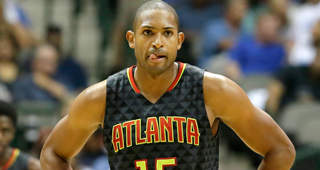There is very little immediately exciting about Al Horford’s game but he’s one of the NBA’s most consistent, versatile and well-rounded talents. Horford offers a ton of lineup combination possibilities with his unique versatility on both sides of the floor. Horford is an All-Star caliber talent not because he changes the game as much as he accentuates the positives his team already possesses.
Horford quintessentially demonstrates the sum of being pretty good at everything makes you really good in the aggregate.
This is also the type of team the Boston Celtics have been over the past two seasons under Brad Stevens as a surprise playoff team in 2015 and nearly a 50-win team in 2016. The success hasn’t translated in the playoffs when their dearth of truly elite players becomes more problematic.
But after two long days of negotiations, Horford agreed to sign with the Celtics on a four-year, $113 million full max contract. The Atlanta Hawks improved their five-year offer up to $136 million but were never prepared to go all the way up to his full max of $153 million.
Horford attempted just 16 three-pointers in his first six NBA seasons combined, 11 in Year 7 and then 256 in Year 8 while shooting at a very competent 34.4 percent. Horford hasn’t merely been a corner three-point shooter even taking above the break three-pointers with regularity. If Horford hadn’t developed that part of the game, it would have been interesting how his free agency at the age of 30 would have played out; certainly with far less dollars and teams interested.
Horford has also become a gifted passer in Atlanta’s ball movement offense and also as a passer and scorer as the roll man. Horford scored 1.13 points per possession as the roll man, which was one of the best rates in the NBA amongst such heavy volume bigs.
But for as much as the Hawks’ offense was celebrated in 14-15 when they ranked sixth in points per 100 possessions, they swiftly dropped to 22nd this past season.
Horford does well defending just about any opposing big regardless if they’re athletic power forwards that also play on the perimeter, or if they are strong centers who score in the post. Horford isn’t a natural rim protector but he maximizes whatever length and athleticism he has by playing smart defense. While the offense dropped, the Hawks ranked second in the NBA in defense and were 1.8 points per 100 possessions better with him on the floor. Horford doesn’t solve Boston’s rim protection issues but they’ve already proven to be a great defensive team without it and he makes them substantially better.
Horford allowed just 0.80 points per possession in the post against the most attempts in the NBA.
Horford also ranked 27th in Real Plus Minus in the entire NBA this past season.
The concern with Horford’s contract has been his anticipated decline in the final years of the contract. This is why the Hawks were so reluctant to go big in Year 5 and it becomes far less problematic for Boston on a four-year deal. Because he’s become such a quality perimeter shooter, Horford should remain a productive, playable player but is still was a harrowing proposition for a smaller market franchise like the Hawks.
Boston has infamously had a ton of assets and a ton of role players and now they finally have a legitimate All-Star who can play both big positions while also spacing the floor. The Celtics sign Horford without giving up any of those assets, which makes it easier to get another star and the versatility he brings makes a number of combination of player(s) a logical fit. Boston had an easier time trading for Kevin Garnett in 2007 after already acquiring Ray Allen in June, so this first signing mirrors that one except it cost Danny Ainge nothing but cap space.
Grade for Celtics: A
Horford could have gone down as the most important player in Hawks’ history, eclipsing even Dominique Wilkins, had he re-signed and played out his career with a single franchise. Horford instead played a lot of quality basketball in Atlanta and 74 playoff games.
The Memphis Grizzlies gave Mike Conley the full max on the first day of free agency, yet the Hawks were never prepared to make that type of commitment to Horford and he was wise to instead move onto a new challenge. The Celtics are capable of evolving into title contenders with their collection of assets and Horford becomes the first major player to choose to join the project.
Horford also received a player option for Year 4, which will allow him the opportunity for one more significant multi-year deal if he maintains his form.
Grade for Al Horford: A
The Hawks have gone 0-for-8 in playoff games against the Cavaliers over the past two offseasons, which made continuing the relationship with Horford uncomfortable, as does the fact Paul Millsap and Kyle Korver are 31 and 35 respectively. Atlanta has been between a retool and continuing their successful regular season status quo this season. While it is unclear if the Hawks will be better or worse without Horford and Jeff Teague, they will certainly be different.
Atlanta seemed to preemptively move on from Horford in signing Dwight Howard on the first day of free agency but they continued to see if a deal could be reached up until the very end, even reportedly shopping Paul Millsap in trade scenarios. It was unclear how earnest their attempts at re-signing Horford actually were or they were playing a PR game.
The Raptors had a similar decision to make with DeMar DeRozan and they chose to keep it rolling even if the deal will hardly seem like a team-friendly one by Year 4 or Year 5. It is admirable, especially for franchises with limited sustained success, to choose loyalty and inertia instead of the commodification of players.
Grade for Hawks: D



